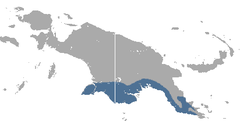Kangurowiec szary
Kangurowiec szary[6] (Dorcopsis luctuosa) – gatunek ssaka z podrodziny kangurów (Macropodinae) w obrębie rodziny kangurowatych (Macropodidae).
| Dorcopsis luctuosa | |||
| (D’Albertis, 1874) | |||
 Ilustracja autorstwa Keulemansa z 1874 roku | |||
| Systematyka | |||
| Domena | |||
|---|---|---|---|
| Królestwo | |||
| Typ | |||
| Podtyp | |||
| Gromada | |||
| Podgromada | |||
| Infragromada | |||
| Nadrząd | |||
| Rząd | |||
| Nadrodzina | |||
| Rodzina | |||
| Podrodzina | |||
| Rodzaj | |||
| Gatunek |
kangurowiec szary | ||
| Synonimy | |||
| |||
| Podgatunki | |||
|
| |||
| Kategoria zagrożenia (CKGZ)[5] | |||
 | |||
| Zasięg występowania | |||

| |||
Taksonomia edytuj
Gatunek po raz pierwszy zgodnie z zasadami nazewnictwa binominalnego opisał w 1874 roku włoski przyrodnik i podróżnik Luigi Maria d’Albertis nadając mu nazwę Halmaturus luctuosus[1]. Miejsce typowe według oryginalnego opisu „południowo-wschodnia Nowa Gwinea” (ang. S. E. of New Guinea)[1][7], tj. Papua-Nowa Gwinea[8][9]. Holotyp to skóra i czaszka na młodocianej samicy (sygnatura BMNH 75.4.16.1) z kolekcji Muzeum Historii Naturalnej w Londynie; okaz typowy odłowiony przez załogę HMS Basilisk i sprzedany d’Albertisowi[10]. Podgatunek phyllis formalnie opisali w 1989 roku brytyjsko-australijski antropolog i zoolog Colin Groves oraz australijski zoolog i paleontolog Tim Flannery nadając mu nazwę Dorcopsis luctuosa phyllis[4]. Miejsce typowe to okolice Merauke (8°30′S 140°22′E/-8,500000 140,366667), Nowa Gwinea, Indonezja[11]. Holotyp to skóra, czaszka i szkielet pozaczaszkowy dorosłej samicy (sygnatura ZMA 5243) z kolekcji Zoölogisch Museum Amsterdam; okaz typowy zebrany w okresie koniec 1959/początek 1960 roku przez A.J.N. Monsanto[11].
Autorzy Illustrated Checklist of the Mammals of the World rozpoznają dwa podgatunki[8].
Etymologia edytuj
Zasięg występowania edytuj
Kangurowiec szary występuje w zależności od podgatunku[8]:
- D. luctuosa luctuosa – niziny wschodniej Papui-Nowej Gwinei.
- D. luctuosa phyllis – rejon rzeki Fly i Merauke w Prowincji Zachodniej w Papui-Nowej Gwinei.
Morfologia edytuj
Długość ciała (bez ogona) samic 25,2 cm, samców 72,1–90 cm, długość ogona samic 31 cm, samców 38–38,8; masa ciała samic 3,6 kg, samców 6,7–11,6 kg[14][15].
Status zagrożenia edytuj
W Czerwonej księdze gatunków zagrożonych Międzynarodowej Unii Ochrony Przyrody i Jej Zasobów został zaliczony do kategorii VU (ang. vulnerable ‘narażony’)[5].
Przypisy edytuj
- ↑ a b c L.M. d’Albertis. Characters of a new Species of Kangaroo (Halmaturus luctuosus) from New Guinea. „Proceedings of the Zoological Society of London”. 1874, s. 110, 1874. (ang.).
- ↑ N. Miklouho-Maclay. On a new species of kangaroo (Dorcopsis Chalmersii) from the south-east end of New Guinea. „Proceedings of the Linnean Society of New South Wales”. 9, s. 569, 1885. (ang.).
- ↑ N. Miklouho-Maclay. On two new species of Dorcopsis from the south coast of New Guinea. „Proceedings of the Linnean Society of New South Wales”. 10, s. 145, 1886. (ang.).
- ↑ a b C.P. Groves & T.F. Flannery: Revision of the genus Dorcopsis (Macropodidae: Marsupialia). W: G. Grigg, P. Jarman & I. Hume (red.): Kangaroos, wallabies and rat-kangaroos. Sydney: Surrey Beatty and Sons Pty. Ltd, 1989, s. 125. ISBN 978-0-949324-23-8. (ang.).
- ↑ a b Dorcopsis luctuosa, [w:] The IUCN Red List of Threatened Species (ang.).
- ↑ Nazwy polskie za: W. Cichocki, A. Ważna, J. Cichocki, E. Rajska-Jurgiel, A. Jasiński & W. Bogdanowicz: Polskie nazewnictwo ssaków świata. Warszawa: Muzeum i Instytut Zoologii PAN, 2015, s. 16. ISBN 978-83-88147-15-9. (pol. • ang.).
- ↑ D.E. Wilson & D.M. Reeder (red. red.): Species Dorcopsis luctuosa. [w:] Mammal Species of the World. A Taxonomic and Geographic Reference (Wyd. 3) [on-line]. Johns Hopkins University Press, 2005. [dostęp 2021-06-15].
- ↑ a b c C.J. Burgin, D.E. Wilson, R.A. Mittermeier, A.B. Rylands, T.E. Lacher & W. Sechrest: Illustrated Checklist of the Mammals of the World. Cz. 1: Monotremata to Rodentia. Barcelona: Lynx Edicions, 2020, s. 92. ISBN 978-84-16728-34-3. (ang.).
- ↑ N. Upham, C. Burgin, J. Widness, M. Becker, C. Parker, S. Liphardt, I. Rochon & D. Huckaby: Dorcopsis luctuosa (D'Albertis, 1874). [w:] ASM Mammal Diversity Database (Version 1.11) [on-line]. American Society of Mammalogists. [dostęp 2023-08-09]. (ang.).
- ↑ G.H.H. Tate. Notes on the types of certain early described species of monotremes, marsupials, Muridae and bats from the Indo-Australian region. „American Museum novitates”. 1061, s. 5, 1940. (ang.).
- ↑ a b W. Bergmans. An annotated list of mammal type specimens in the collections of the former Zoological Museum of the University of Amsterdam (1890–2010). „Zoologische Mededelingen”. 85 (12), s. 836–837, 2013. (ang.).
- ↑ T.S. Palmer: Index Generum Mammalium: a List of the Genera and Families of Mammals. Washington: Government Printing Office, 1904, s. 243, seria: North American Fauna. (ang.).
- ↑ luctuosa, [w:] The Key to Scientific Names, J.A. Jobling (red.), [w:] Birds of the World, S.M. Billerman et al. (red.), Cornell Lab of Ornithology, Ithaca [dostęp 2023-08-09] (ang.).
- ↑ M. Eldridge & G. Coulson: Family Macropodidae (Kangaroos and Wallabies). W: D.E. Wilson & R.A. Mittermeier (red.): Handbook of the Mammals of the World. Cz. 5: Monotremes and Marsupials. Barcelona: Lynx Edicions, 2015, s. 694. ISBN 978-84-96553-99-6. (ang.).
- ↑ Class Mammalia. W: Lynx Nature Books (A. Monadjem (przedmowa) & C.J. Burgin (wstęp)): All the Mammals of the World. Barcelona: Lynx Edicions, 2023, s. 62. ISBN 978-84-16728-66-4. (ang.).